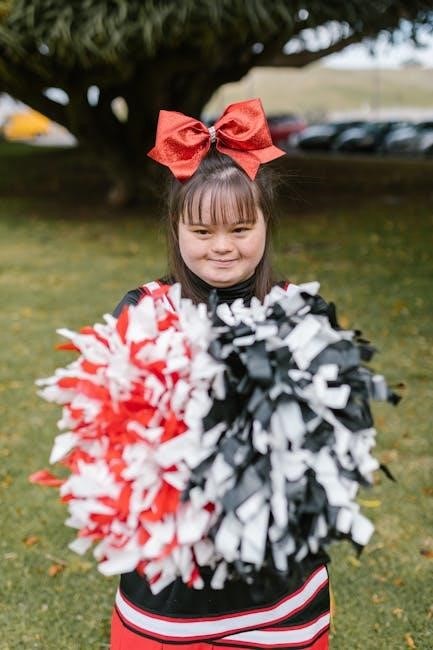Anne Fadiman’s The Spirit Catches You and You Fall Down explores the cultural collision between a Hmong family and Western medicine, highlighting the tragic consequences of misunderstanding․
1․1 Overview of the Book

The Spirit Catches You and You Fall Down by Anne Fadiman is a poignant narrative that delves into the cultural and medical struggles of a Hmong refugee family in California․ The book centers on Lia Lee, a young Hmong girl diagnosed with epilepsy, whose condition becomes a focal point of conflict between her family’s spiritual beliefs and the Western medical system․ Fadiman meticulously explores the deep-seated cultural differences that lead to tragic consequences, highlighting the challenges of cross-cultural communication and the limitations of a one-sided medical approach․ Through extensive research and personal interviews, Fadiman weaves a compelling story that not only sheds light on the Hmong community’s resilience but also advocates for a more inclusive and compassionate healthcare system․
1․2 Author Anne Fadiman and Her Approach
Anne Fadiman, a journalist and literary critic, brings a unique perspective to The Spirit Catches You and You Fall Down through her meticulous research and balanced storytelling․ Her nine-year exploration of the Lee family’s story reflects her commitment to understanding both Hmong culture and Western medicine․ Fadiman avoids taking sides, instead presenting a nuanced narrative that highlights the complexities of cultural misunderstandings․ Her approach blends ethnography, journalism, and personal narrative, creating a deeply human story that resonates beyond the medical and cultural realms․ By giving voice to both the Lee family and their doctors, Fadiman fosters empathy and understanding, ultimately advocating for a more inclusive approach to healthcare and cross-cultural communication․
1․3 Historical Context of the Hmong People

The Hmong people trace their origins to China, where they faced centuries of persecution and marginalization, leading to their migration to Southeast Asia․ During the Vietnam War, the Hmong allied with the U․S․, suffering heavy losses and displacement․ Post-war, many resettled in the U․S․, bringing their rich cultural traditions and spiritual beliefs․ Their history of resilience and adaptation is central to Fadiman’s narrative, highlighting their strong identity and communal values․ The Hmong’s experience as refugees in America underscores the cultural and medical challenges explored in the book, particularly their encounters with a vastly different healthcare system․ Their story reflects a broader struggle to preserve heritage while navigating a new world․
The Hmong Culture and Beliefs

The Hmong culture is deeply rooted in spiritual beliefs, emphasizing harmony with nature and ancestors․ Their traditional practices, led by shamans, address illness as spiritual imbalance, often through rituals and sacrifices․
2․1 Hmong Traditional Healing Practices
The Hmong people rely on traditional healing practices deeply tied to their spiritual beliefs․ Central to these practices is the role of the shaman, or tvix neeb, who performs rituals to restore balance and harmony․ These rituals often involve chanting, offering sacrifices, and the use of herbs․ The Hmong believe that illness is frequently caused by spiritual factors, such as soul loss or the displeasure of spirits․ Shamans are believed to communicate with the spiritual realm to diagnose and treat ailments․ Additionally, animal sacrifices and healing ceremonies, such as ua neeb, are conducted to placate spirits and heal the sick․ These practices reflect the Hmong’s holistic understanding of health, blending physical and spiritual well-being․
2․2 The Role of the Shaman (Tvix Neeb)
The shaman, or tvix neeb, holds a revered position in Hmong culture, acting as a bridge between the physical and spiritual worlds․ Shamans perform rituals to diagnose and treat illnesses believed to stem from spiritual imbalances, such as soul loss or displeased ancestors․ Through chanting, offerings, and meditation, they communicate with spirits to restore harmony․ Their role extends beyond healing, as they also interpret cultural and spiritual traditions, ensuring the community’s well-being․ In The Spirit Catches You and You Fall Down, the shaman plays a vital part in Lias treatment, highlighting the clash between spiritual and medical approaches․ Their influence underscores the Hmong’s deep reliance on spiritual healing as integral to their identity and health practices․
2․3 Spiritual Understanding of Illness
In Hmong culture, illness is deeply intertwined with spirituality․ The Hmong believe that many ailments, including epilepsy, stem from spiritual imbalances such as soul loss or displeasure from ancestors․ This understanding is central to their worldview, where the physical and spiritual realms are inseparable․ Rituals and sacrifices are often performed to restore balance, and shamans (tvix neeb) play a pivotal role in diagnosing and treating these spiritual afflictions․ The phrase “the spirit catches you and you fall down” reflects this belief, attributing seizures to spiritual forces rather than biological causes; This spiritual framework shapes how the Hmong approach health and healing, emphasizing harmony with the divine and ancestral realms․

The Lee Family’s Story
Lia Lee, a Hmong girl with epilepsy, faces cultural and medical conflicts in California․ Her family’s traditional beliefs clash with Western medicine, highlighting their resilience and struggles․
3․1 Lia Lee and Her Condition
Lia Lee, a young Hmong girl, suffered from severe epilepsy, diagnosed as “qaug dab peg” by her family, meaning “the spirit catches you and you fall down․” Her condition began at three months old, leading to frequent, uncontrolled seizures․ While her parents believed her illness was spiritual, caused by a wandering soul, Western doctors viewed it as a neurological disorder requiring medication․ The cultural divide deepened as her parents preferred traditional healing, including shamanic rituals, over pharmaceutical treatments․ Lia’s condition worsened due to misunderstandings and conflicting approaches, ultimately resulting in brain damage from status epilepticus․ Her story highlights the tragic consequences of cultural miscommunication in healthcare․ Lia’s life became a symbol of the clash between two worlds, leaving her in a vegetative state․ Her condition underscored the urgent need for cross-cultural understanding in medical practice, as her family’s spiritual beliefs and the medical system’s reliance on science failed to align, leading to devastating outcomes․ Lia’s experience remains a poignant example of the challenges faced by refugee families navigating unfamiliar healthcare systems while clinging to their cultural traditions․
3․2 The Family’s Perspective on Lia’s Illness
Lia’s family believed her seizures were caused by “qaug dab peg,” or “the spirit catches you and you fall down,” a condition they viewed as spiritual rather than medical․ They attributed her illness to the wandering of her soul, which they believed could be restored through traditional Hmong healing practices, such as rituals and animal sacrifices performed by a shaman (tvix neeb)․ The Lees saw Lia’s condition as a potential sign of spiritual strength, possibly indicating her future role as a shaman․ They were skeptical of Western medication, fearing it would interfere with spiritual healing and harm Lia further․ This belief system clashed sharply with the medical community’s approach, leading to misunderstandings and conflict․ The family’s perspective underscored the deep cultural and spiritual significance they placed on Lia’s condition, viewing it as a sacred matter rather than a purely biological one․
3․4 The Cultural Divide in Medical Treatment
The cultural divide in medical treatment was a significant barrier in Lia’s case, as her family and doctors held fundamentally different beliefs about her condition․ While the medical team viewed Lia’s epilepsy as a neurological disorder requiring pharmaceutical intervention, her parents saw it as a spiritual issue caused by the wandering of her soul․ This clash led to mistrust and non-compliance, as the Lees feared Western medication would interfere with spiritual healing․ The doctors, in turn, saw the family’s resistance as non-compliant and uncooperative․ This mutual misunderstanding worsened Lia’s condition and highlighted the profound gap between Western medicine’s focus on biology and the Hmong’s holistic, spirit-centered approach to health․ The lack of cultural understanding on both sides exacerbated the tragedy․
The Medical Perspective
The medical perspective diagnoses Lia with epilepsy, focusing on neurological causes and pharmaceutical treatments․ Doctors view her condition through a biological lens, emphasizing modern medical interventions․
4;1 Western Medical Diagnosis and Treatment
Western medical professionals diagnosed Lia Lee with epilepsy, attributing her seizures to neurological misfires in the brain․ They prescribed anticonvulsant medications to control her symptoms, believing these drugs would stabilize her condition and prevent further neurological damage․ The medical team viewed Lia’s illness through a biological lens, focusing on measurable, scientific evidence to guide their treatment decisions․ However, their approach often clashed with the Hmong family’s spiritual beliefs, leading to misunderstandings and resistance․ Despite their good intentions, the doctors struggled to communicate effectively with Lia’s parents, failing to address their concerns about medication side effects and spiritual healing practices․ This disconnect hindered effective treatment and exacerbated the cultural divide․
4․2 The Doctors’ Understanding of Epilepsy
The doctors viewed Lia Lee’s condition as a neurological disorder, specifically epilepsy, caused by abnormal electrical activity in the brain․ They believed her seizures resulted from misfiring brain cells, which could be controlled with anticonvulsant medication․ Western medicine focused on the biological and measurable aspects of her illness, seeking to stabilize her condition through scientific evidence and medical protocols․ The doctors saw epilepsy as a physical condition requiring a pharmacological solution, with the goal of preventing further brain damage․ However, their understanding clashed with the Hmong belief in spiritual causes, creating a gap in communication and treatment approach․ This scientific perspective shaped their decisions, often overlooking the family’s cultural beliefs․
4․3 Challenges in Cross-Cultural Communication
Effective communication between Lia’s doctors and her Hmong family was severely hindered by cultural and linguistic barriers․ The Lees believed Lia’s seizures were caused by spiritual forces, while doctors viewed them as a neurological disorder․ This fundamental disagreement led to mistrust and miscommunication․ The term “noncompliance” was often used by medical staff, but it reflected a lack of understanding of the Hmong perspective․ Language barriers further complicated matters, as interpreters were not always available․ The clash of belief systems created tension, with the family fearing medication would interfere with spiritual healing․ These challenges highlight the struggles of navigating cross-cultural interactions in healthcare, emphasizing the need for empathy and mutual understanding to bridge such divides․

The Clash of Two Worlds
The book vividly portrays the conflict between Hmong spiritual beliefs and Western medical practices, highlighting the misunderstandings and tension that arise when two worlds collide․
5․1 Conflicting Views on Health and Illness
The Hmong viewed Lia’s epilepsy as a spiritual condition, believing her soul was wandering, while Western doctors saw it as a neurological disorder․ This clash of perspectives led to significant misunderstandings, as the Lees sought spiritual healing through rituals and shamans, while medical professionals emphasized pharmaceutical treatments․ The Hmong believed excessive medication would interfere with spiritual balance, while doctors viewed non-compliance as a barrier to effective care․ These deeply rooted cultural differences in understanding health and illness created a chasm, with each side struggling to comprehend the other’s approach․ The conflict highlighted the challenges of navigating health care across vastly different belief systems․
5․2 Medication vs․ Spiritual Healing
The conflict between medication and spiritual healing lies at the heart of Lia Lee’s story․ Western doctors prescribed anticonvulsants to control her seizures, viewing medication as essential for managing her epilepsy․ In contrast, the Hmong believed that spiritual healing through shamans (tvix neeb) and rituals was necessary to restore Lia’s wandering soul․ The Lees feared that too much medication would interfere with these spiritual practices, believing it could harm her further․ This tension led to mistrust and non-compliance, as the family sought to balance both approaches․ The clash between these two methodologies highlights the profound cultural divide in understanding and treating illness, ultimately exacerbating Lia’s condition and illustrating the need for cross-cultural understanding in healthcare․

5․3 The Impact of Cultural Misunderstanding
Cultural misunderstanding deeply exacerbated Lia Lee’s condition, as her doctors and parents held conflicting views on illness․ The medical team viewed her seizures as a neurological disorder requiring medication, while the Hmong believed her soul was lost, necessitating spiritual healing․ This misalignment led to mistrust and non-compliance, with the Lees fearing medication would harm Lia spiritually․ The clash highlighted the devastating consequences of cultural insensitivity in healthcare․ Without a bridge between these worlds, Lia’s treatment became a battleground, resulting in her severe brain damage․ The tragedy underscores the urgent need for cross-cultural communication and understanding to prevent such failures in patient care․

The Role of Power Dynamics
The imbalance of power between the medical system and the Hmong family exacerbated tensions․ Doctors held authority, while the Lees resisted external control, highlighting cultural resistance to dominance․
6․1 Authority and Trust in Medical Settings
The medical system’s authority often clashed with the Hmong family’s trust in their spiritual beliefs․ Doctors, representing Western medicine, held significant power, while the Lees struggled with the rigid, one-sided approach․ Lia’s parents distrusted the medical system due to its dismissiveness of their spiritual practices․ The doctors’ authority was perceived as coercive, particularly when Child Protective Services intervened, undermining the family’s autonomy․ This power imbalance deepened the cultural divide, as the Lees felt their beliefs were disrespected․ The medical system’s reliance on hierarchy and compliance further eroded trust, highlighting the need for mutual respect in cross-cultural healthcare encounters․ The lack of understanding on both sides exacerbated the tragedy, revealing systemic flaws in authority dynamics․
6․2 The Hmong Resistance to External Authority
The Hmong’s historical experiences as refugees and their resilience against oppressive regimes fostered a strong resistance to external authority․ Their cultural identity, deeply rooted in independence and self-reliance, made them wary of Western institutions․ Lia’s parents, Foua and Nao Kao, viewed the medical system’s rigid directives as a threat to their autonomy and spiritual beliefs․ The Hmong’s skepticism toward external authority was compounded by their belief in the spiritual causes of illness, which clashed with the medical system’s biological explanations․ This resistance was not just about noncompliance but a protective stance to preserve their cultural integrity and family unity in a foreign environment․ Their history of enduring oppression reinforced their reluctance to surrender to external control, even in life-threatening situations․
6․3 The Involvement of Child Protective Services
The involvement of Child Protective Services (CPS) in Lia Lee’s case marked a turning point in the conflict between her family and the medical system․ When Lia’s parents refused to administer prescribed medications, her doctor, Neil Ernst, reported them to CPS, leading to Lia’s placement in foster care․ This action escalated the cultural misunderstanding into a legal battle, highlighting the power imbalance between the Hmong family and the state․ The CPS intervention reflected the systemic prioritization of Western medical authority over cultural beliefs, further alienating the Lee family․ This chapter underscores how institutional power can exacerbate conflicts, turning a medical issue into a legal and cultural crisis․

The Concept of Cultural Competence
Cultural competence emphasizes understanding and bridging cultural differences in healthcare․ It advocates for mutual respect, communication, and collaboration between medical providers and diverse patient communities․
7․1 The Need for Mutual Understanding
Mutual understanding is crucial in bridging the gap between Western medicine and traditional Hmong beliefs․ In The Spirit Catches You and You Fall Down, the Lees’ story highlights the tragic consequences of cultural miscommunication․ The Hmong viewed Lia’s seizures as spiritual, while doctors saw them as neurological․ This clash stemmed from differing explanatory models of illness, leading to mistrust and conflicting approaches to treatment․ Mutual understanding could have fostered collaboration, allowing both sides to respect each other’s perspectives․ By valuing the Hmong’s spiritual beliefs and integrating them with medical practices, a more holistic approach might have been achieved․ This underscores the importance of cultural sensitivity in healthcare to ensure patient well-being and trust․
7․2 The Role of Mediators in Healthcare
Mediators play a vital role in healthcare by bridging cultural gaps between patients and providers․ In The Spirit Catches You and You Fall Down, the absence of a mediator exacerbated the Lees’ conflict with Western medicine․ A mediator could have facilitated dialogue, ensuring both sides understood each other’s beliefs and priorities․ For instance, Dwight Conquergood’s work with the Hmong demonstrates how integrating traditional practices with medical advice fosters trust․ Similarly, medical anthropologists or bilingual community members could act as mediators, translating not just language but also cultural values․ Their involvement could have helped the Lees and Lia’s doctors find a balanced approach, respecting spiritual healing while ensuring safe medical treatment․ Such collaboration is essential for improving cross-cultural healthcare outcomes․
7․3 Lessons for Medical Practitioners
Medical practitioners can learn valuable lessons from The Spirit Catches You and You Fall Down, particularly regarding cultural sensitivity and communication․ The book underscores the importance of understanding patients’ cultural beliefs and incorporating them into treatment plans․ Anne Fadiman’s narrative highlights how rigid medical protocols and cultural misunderstandings can lead to adverse outcomes․ Practitioners should strive to balance empirical knowledge with empathy, respecting patients’ traditions while providing evidence-based care․ Open dialogue and collaboration with cultural mediators can enhance trust and improve health outcomes․ Ultimately, the book advocates for a more inclusive approach to medicine, where both Western practices and traditional healing are valued, ensuring holistic care that respects the whole person․

The Legacy of the Book
The Spirit Catches You and You Fall Down has profoundly impacted medical anthropology, advocating for cultural competence and inspiring changes in healthcare practices, remaining highly relevant today․
8․1 Impact on Medical Anthropology
Anne Fadiman’s The Spirit Catches You and You Fall Down has become a cornerstone in medical anthropology, illustrating the critical need for cultural understanding in healthcare․ By detailing the clash between Hmong spiritual beliefs and Western medical practices, the book highlights how cultural miscommunication can lead to tragic outcomes․ It has inspired a shift in anthropological studies, emphasizing the importance of integrating cultural perspectives into medical systems․ Fadiman’s work challenges healthcare providers to move beyond biological diagnoses and consider the social and spiritual dimensions of illness․ This approach has reshaped how anthropologists and medical professionals view cross-cultural interactions, advocating for a more holistic and empathetic healthcare system․ The book remains a pivotal text in promoting cultural competence and patient-centered care․
8․2 Changes in Healthcare Practices
The Spirit Catches You and You Fall Down has driven significant changes in healthcare practices by emphasizing the importance of cultural competence․ The book highlights the need for medical professionals to understand and respect patients’ cultural beliefs, particularly in cases where spiritual and medical views collide․ Many healthcare institutions have adopted cross-cultural training programs to improve communication between providers and patients from diverse backgrounds; Additionally, the integration of traditional healing practices alongside Western medicine has become more accepted, fostering a more holistic approach to care․ The use of mediators and interpreters has also increased, ensuring that patients’ voices and beliefs are considered in treatment plans․ These changes aim to bridge cultural gaps and improve patient outcomes, reflecting the book’s enduring influence on modern healthcare․
8․3 The Book’s Relevance Today
The Spirit Catches You and You Fall Down remains highly relevant today, offering valuable insights into cultural competence in healthcare․ Its exploration of the Hmong experience continues to resonate in an increasingly diverse society․ The book is widely used in medical, anthropological, and educational settings to teach the importance of understanding cultural differences․ It highlights the ongoing challenges of cross-cultural communication and the need for healthcare providers to adapt their approaches to respect patients’ beliefs․ Fadiman’s work has inspired reforms in patient care, emphasizing the importance of integrating traditional practices with modern medicine․ Its lessons are particularly timely in addressing disparities in healthcare access and delivery for marginalized communities, ensuring its enduring impact on both medical practice and societal understanding․
